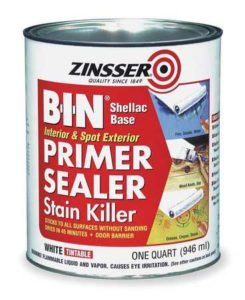Primer know how is not hard to acquire. Knowing which primer to use and when is easy and I will share a few tricks as well. Primers basically do one of two things. They deal with a problem or they prevent a problem for occurring. For example primers that act as a sealer deal with water stains, smoke stains and odor, etc. (problems). Bonding primers act as an intermediary coat between the substrate and the top coat. They ensure a good bond of the top coat to substrate, (prevent problem).
Types of Primers
Sealers. As previously mentioned, they seal problems like water stains, smoke, etc. The big daddy of them all is Shellac. My favorite is BIN. If this stuff doesn’t seal your stain, you have a real problem. This is what you use when all else fails or if your smart, just go to this to begin with. It has some odor but it’s not as bad as KILZ. One caveat, make certain the substrate is completely dry before application.
Bonders. These make sure your top coat stays where you put it. If you want to paint over a semi-gloss finish, one coat of a bonding primer will guarantee success. I have two favorites. Gripper and Seal Grip. Both are latex and both are great products. Many years ago I tested many different primers on many different materials such as glass, tile, metal, etc. The Gripper and Seal Grip outperformed primers costing three times more. I almost always have a gallon of Gripper and a gallon of BIN on hand. Bonding primers can be latex (water base) or alkyd (oil base).
High build. These are for use on drywall. They can be laid out fairly thick when spraying without having to worry about sagging. Typically used to help smooth out and hide imperfections in a drywall finish.
Rust Inhibitive. As the name implies, intended to be applied to a metal surface to seal and bond to rust. When you have a rusty surface you want to try to eliminate as much rust as possible before priming. One trick I learned long ago was to use straight Penetrol on rusty metal. Allow it to dry 24 hours and then top coat it with a quality DTM product. DTM= direct to metal coating.
There are additional primers such as epoxy primers, mold killing, water proofing, etc. but the above primers are the most commonly used. At The Painting Company we prime everything and always do two top coats. It’s a good habit to get into to guarantee success. Another trick is to tint your primer when possible. Most can take up to 5 oz of tint per gallon and some primers come in different bases that makes it easier to tint. Always tint 100% or as close to the finish color as possible. Many stores will suggest going 50% or so. The rational is ” so you can keep track of where you are at” as you roll your finish coat. Trust me, go 100% if possible.
Situations that require a primer:
Wood: Use a quality oil or latex primer.
Bare Metal: A DTM or rust inhibitive primer.
New Drywall: Latex primer.
Drywall Patches: Latex primer.
Spackled Holes: Latex primer.
Chalky Areas: Clean well and then Latex primer.
Stains: Oil base or shellac primer.


